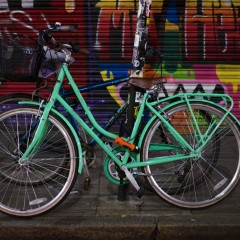From a spartan office in Houston’s East End, Will Rub – along with just a handful of employees – oversees the bike-sharing network that’s helping to transform parts of the city.
When the system debuted in 2012, there wasn't much to it – just 18 bikes spread across three stations.
Now, thanks to a $3.5 million award from the Houston-Galveston Area Council, the system is poised to add 71 new stations (it has 29 today) and 568 bikes (on top of the 190 it has now) within the next three years.
In reality, Rub hopes to spend all the money within the next 18 months. To put it bluntly: he’s about to get a whole lot busier.
“It’s easy to be excited about what’s going on,” Rub said.
Rub spoke from his office in October, just a few weeks after the bike-sharing system had its busiest day ever: 789 bikes checked out on a recent Saturday, or about four checkouts for each bike in the network.
“The need for it is now here, and people are more accepting of it,” Rub said.
The expansion will be spaced out evenly across three stages, starting first with new stations near Rice Village and the Texas Medical Center. Already, BCycle has vetted the locations of the new sites, which are generally just off campus near buildings that house students, or within about a block of the medical center’s footprint.
After that, more stations will come to Midtown, Montrose and the Washington Avenue Corridor. Lastly, the expansion will move eastward towards the campuses of University of Houston and Texas Southern University.
“It’s almost a shotgun approach,” Rub said. After years of having a relatively small network, Rub is eager to go big – and fast.
The idea is to focus on areas that are dense – where lots of apartments and condos are located – since that’s where potential BCycle riders are likely to live. Their target customers are people who enjoy using bicycles but either don’t want to lug one up and down a high-rise or may not have the time or skills to maintain a bike.
“Vertical housing is a critical component of success if you don’t have vertical employment,” Rub said. He said the system’s expansion simply wouldn’t work in areas where single-family homes dominate, in large part because residents have garages where they can easily keep bicycles of their own.
The other target customer is people who might be able to rely on transit – including the city’s newly redesigned bus network and its light rail lines – but start or end their trip beyond walking distance from transit. The idea is to make it as easy as possibly for people to use transit, so providing a bike might help them access a line that would otherwise be beyond reach.
Eventually, Rub sees the stations be installed as far west as Memorial Park and as far north as The Heights, but they’re not likely to expand beyond Houston’s inner core.
“There’s no doubt, all bike-share programs have to grow from the epicenter of the population density and employment density,” Rub said.
As new stations come online, Houston BCycle will also likely expand its hours of operation. Unlike bike-sharing systems on the East Coast, Houston’s BCycle does not make its bikes available for 24/7 – though Rub said that may change.
One thing that sets Houston’s BCycle system apart from others on the East Coast is that so many of its customers are casual users who use the bikes only occasionally for recreational use and not commuting, Rub said. Data analyzed by Kinder Institute researchers confirmed that trend. Only about 50 Houstonians use BCycle daily to get to work, Rub said.
Rub classified about 80 percent of Houston BCycle’s customer base as “casual users.” On the other hand, in places like the East Coast, about 80 percent of bike-share customers have annual subscriptions, suggesting they use the service more often.
Even though BCycle itself is unlikely to put a dent in Houston’s massive congestion problem, Rub said he sees the bike-share network providing a valuable service in a rapidly changing city.
He touts the health benefits of bicycles, the convenience of using a bike for a short trip rather driving (and parking) a car, and the ability of bike-sharing to expand the reach of transit.
“We’re creating a transportation alternative,” Rub said. “We’re providing an option.”


